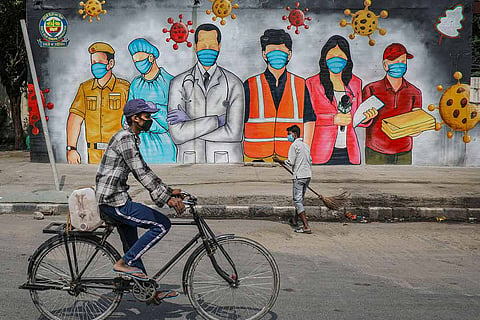

In a span of a week, Bengaluru has seen a significant rise in the number of individuals admitted with symptoms of influenza-like illness (ILI) testing positive for SARS-CoV-2, the virus which causes COVID-19.
According to M Lokesh, the special commissioner and COVID surveillance in charge from the Bruhat Bengaluru Mahanagara Palike (BBMP), there has been an increase in ILI in many hospitals, and many were found to be positive for the SARS-CoV-2 virus.
Like COVID-19, ILI and Severe Acute Respiratory Illness (SARI) are respiratory infections, with symptoms such as fever, and cough being common. However, while COVID-19 is caused by the SARS-CoV-2 virus, ILI and SARI can be caused by a range of viruses including H1N1, H7N9, other coronaviruses such as MERS and in some cases bacteria as well.
Lokesh explained that the rise in ILI cases now suggests ths spread of the SARS-CoV-2 virus in the city. “What this means is that more people have been infected with SARS-CoV-2 in the recent past. Earlier, because of lockdown, contact tracing was very good and contacts were minimal. Since June 8, everything has been opened so any cases turning positive, we have to double up on contact tracing efforts and we need to rope in more people for this, which we are working on,” he said.
The World Health Organisation (WHO) has long had a global influenza surveillance program in place. This has allowed for certain protocols to be set in place, which acts as red flags in the event that a specific country or part of the world is reporting a sudden outbreak of influenza.
“The WHO categorises ILI as an acute respiratory infection along with cough and a high fever that has been present for 10 days or less. As part of its surveillance program against influenza, both ILI and SARI (severe acute respiratory infection) are used as benchmarks to determine the severity of any outbreaks of influenza,” explains Dr Nagaraj, director of the Rajiv Gandhi Institute of Chest Diseases (RGICD) in Bengaluru.
He further goes on to explain that all forms of influenza cause similar symptoms: fever, cough and breathing difficulties, regardless of whether it is the swine flu, a seasonal flu or even as seen in the case of the SARS (severe acute respiratory syndrome).
To quickly identify any potential new influenza viruses, the WHO has a surveillance program dedicated to monitoring for sudden appearance of a cluster of these symptoms in any part of the world. In this manner, the WHO was able to identify that several people in Wuhan developed pneumonia-like symptoms at the start of the COVID-19 pandemic.
This is why the WHO has emphasized the importance of routinely monitoring ILI and SARI in every country.
An increase in the number of ILI cases turning positive for SARS-CoV-2, is a possible indicator that the virus is manifesting in more individuals in less severe manners. This is why anyone who develops symptoms of ILI should closely monitor themselves and get medical attention as soon as possible, if any of their symptoms worsen or don’t subside on their own.
The bulletin released by the health department on June 13 shows that out of 308 confirmed new cases of COVID-19, 31 were reported from Bengaluru. Of these 31, a total of 12 individuals were found to have been admitted for ILI who later were found to have contracted SARS-CoV-2. This makes for a total of 38.7% of COVID-19 cases on June 13 alone. On June 12, there were 271 positive cases of COVID-19 reported by the state’s health department of which 36 were from Bengaluru. Of these 36 new cases, 12 of them were those who had been admitted with a diagnosis of ILI, accounting for 33.3% of all positives.
On June 11, out of 17 positives in Bengaluru, 6 had initially been admitted as ILI accounting for 35% of the COVID-19 cases on that day alone. Just a day prior on June 10, out of 42 total number of individuals found to be positive for SARS-CoV-2 in Bengaluru, 22 had been reported to be admitted with ILI. This represented a whopping 52.4% of all cases of COVID-19 reported on June 10 alone.
While ILI cases have been under the scanner of health officials, the trend of the number of ILI cases turning out to be positive for SARS-CoV-2 has increased substantially. Looking at data from mid and early May shows little to no ILI cases reported positive in the state. In early June, a sizable proportion of individuals confirmed to be positive for COVID-19 in Bengaluru had initially been diagnosed with ILI.
Lokesh said that with regards to ILI and SARI cases, it is important to note that the person may just present with fever for 3 to 4 days. “However, this isn’t necessarily only due to COVID-19. It could just as easily be a case of dengue, viral fever or any number of other issues which manifests in similar ways. However, if someone is suspected (based on history and examination) of having COVID-19, then we have to test them. If they are found to be positive for COVID-19 they are sent to Victoria Hospital. Those with ILI but are non-COVID cases are sent home,” he said.
With inputs from Soumya Chatterjee